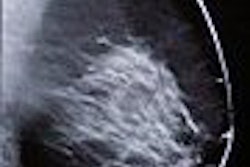In the past, consensus in the breast cancer clinical community has been that a woman's chances of overall survival are not influenced by the interval development of bilateral, multiple-occurring cancers.
Yet the paradigm is shifting, with more evidence pointing to a shorter disease-free survival for women with these kinds of breast cancers than for those with unilateral breast cancer. For patients with a history of breast cancer, the key questions are which screening modality to use and how often screening should occur.
Researchers at Yonsei University College of Medicine in Seoul, South Korea, evaluated sonography's role in the early detection of multiple-occurring, contralateral breast cancers. They found that the combination of annual sonography exams and mammography contributed to the early detection of these cancers, particularly in women with dense breast tissue. They published their results in the American Journal of Roentgenology (February 2008, Vol. 190:2, pp. 476-480).
Dr. Min Jung Kim and colleagues retrospectively reviewed pathologic, mammographic, and sonographic records of 51 patients with surgically confirmed metachronous bilateral breast cancer, found from 2,498 surgically confirmed breast cancers between 2000 and 2006.
The 51 women had undergone both mammography (Selenia Full Field Digital Mammography system, Hologic, Bedford, MA) and bilateral whole-breast sonography (ATL HDI 5000 or 3000, Philips Healthcare, Andover, MA) in their preoperative evaluations, as well as whole-body bone scanning and chest CT to rule out metastasis.
The team compared cancer staging based on whether a patient was in a screened group, in which both a mammogram and sonogram were taken within 12 months of the pathologic diagnosis of metachronous cancer. Within this particular group, Kim and colleagues compared cancer staging based on whether a screening sonogram was taken within six months of the metachronous cancer diagnosis.
The mean interval between the detection of the first and second cancers was 82 months. Patients underwent contralateral breast examinations for two reasons: a palpable mass (21 patients) and screening (30 patients). The mean pathologic size of metachronous breast cancers was 1.9 cm.
The study's limitations include a small patient cohort and short follow-up period; because the team couldn't assess the survival benefit with sonography surveillance, it couldn't generalize the results. The study also did not assess the frequency of further study rates or false-positive biopsy rates from using sonography with mammography.
However, the results showed that the sensitivity of finding metachronous breast cancers for sonography was 94% and 80% for mammography. Of the metachronous breast cancers included in the study, 14% were detected by sonography alone, suggesting that annual sonography, in conjunction with mammography, contributes to early detection of these cancers, according to the authors.
By Kate Madden Yee
AuntMinnie.com staff writer
February 25, 2008
Related Reading
Breast sonoelastography aids in evaluating breast lesions, January 28, 2008
Elasticity imaging finds breast tumors based on shape, volume, December 14, 2007
New techniques in breast ultrasound may find more cancers, March 1, 2007
US elasticity testing could cut breast biopsies by half, November 28, 2006
Streaming US, elastography US give clearer picture of breast lesions, June 16, 2006
Copyright © 2008 AuntMinnie.com



















